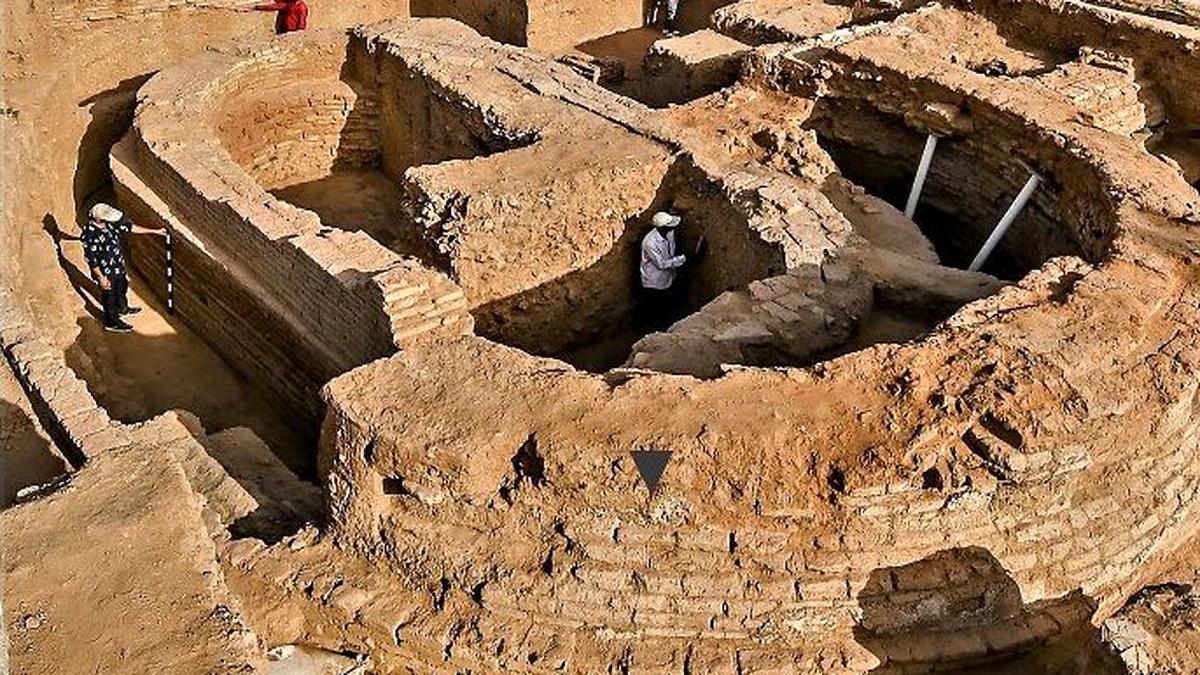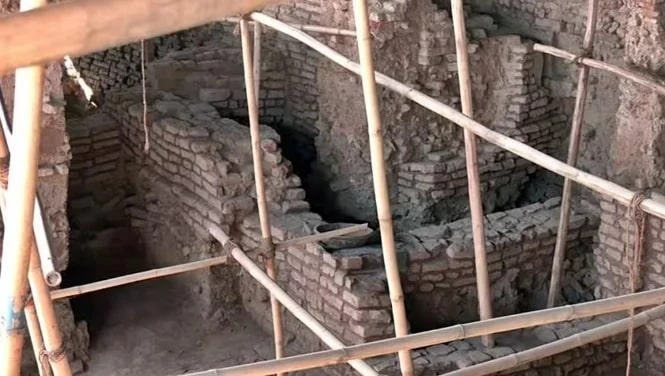The Wonder of Vadnagar: Explorations on a Site Marked by Cultural Continuity
- EIH User
- March 24, 2025

The Wonder of Vadnagar: Explorations on a Site Marked by Cultural Continuity
Article By – Inika Choudhary
India has seen numerous cultures and dynasties rise and fall. From the period of the earliest protohistoric civilisation of the Indus Valley and its decline, to the Vedic culture, there is little data, and hence this particular period is known as the ‘Dark Ages’, leaving the fall of the Indus Valley as an enigma. The next clearly marked period is the Vedic age, followed by the Mahajanapadas and Mauryans, which constitute the Iron Age. However, these developments were also only restricted to the Gangetic plains. 2024 was the culmination of around eight long years of explorations, which have led historians to uncover traces of a probable continuous settlement at Vadnagar in Gujarat, making cultural continuity a possibility.
Introduction to the Site
Vadnagar is currently located in Gujarat and experiences a semi-arid to arid climate. The region has low rainfall and the two rivers Sabarmati and Rupen are located almost 30 kilometres away from the site. It is from Hiuen Tsang’s travel account ‘Travels in India’ that we come across this site of the 7th century CE, referred to by the traveller as O-nan-to-pu-lo, or as known then, Anandpura, meaning City of Joy. Xuanzang wrote of how the city boasted of a dense population, rich establishment, a 2000 Li circuit (0.5 km), and around ten Sangharama or monasteries housing about a thousand monks.
Vadnagar is truly a treat to the archaeologist – it presents an extraordinary stratigraphy with distinguishable layers of different eras and kingdoms that the site housed. The cultural sequence is thicker than 20 metres and is divided into numerous cultural periods. Period I is the Pre-Rampart phase, which provides evidence of modest and simple housing and human inhabitation aided by the presence of the Sharmishtha Lake in the North. The Rampart Phase is Period II, seen as an overlay above the previous phase. Following this, the Kshatrapa Phase (Period III) and the Post-Kshatrapa Phase (Period IV) yet again see the continuation of the structural features but with the introduction of new planning patterns. The cultural assemblage of the space points out greater economic activities taking place and the development of the region as an important port. The subsequent phases are Solanki (Period V), Sultanate-Mughal (Period VI) and Gaekwad/British Colonial (Period VIII).
A Survey of the Findings
While the identification of a Buddhist monastery and elliptical congregation hall is important, the landmark finding is evidence of settlement as early as 2754 years B.P. A survey of the mid-Holocene virgin soil and its contact with the first layer of settlement presents a geological hiatus that predisposes us to the first human habitation at Vadnagar being close to the second urbanisation phase of the Mahajanapadas. This period is characterised by large-scale trade, both national and international, the composition of sacred Hindu Vedic texts like the Yajurveda, some of the first mentions of the use of iron, and the expansion of agriculture. This settlement followed the collapse of the Indus Valley Civilisation, and although one cannot determine directly whether the IVC was its antecedent, it is significant to note that large-scale eastward migration during the Early Iron Age was recorded in North Gujarat, as theorised by scholars like Anindya Sarkar, professor at IIT Kharagpur, who has worked extensively on the site (see Sarkar et. al., 2020).
Arid phases were seen during the Mauryan, Indo-Greek, and Saka-Kushana empires, and they were marked by a general decline in material culture. The Kshatrapa prolonged arid phase witnessed large-scale social instability, and the fall of the Gupta empire served as a precursor to massive deurbanisation, famines, and population contractions. Travelogues from this time around too refer to the collapse of major towns. The Tripartite Struggle was also a product of this time. Even later, the Mughal rule was also plagued by constant famines, the Durgadevi Famine (1396-1408 CE) being a major disruption. It is possible that the drying up of the Sharmishtha Lake set the ball rolling in this series of dry spells.
Even after such setbacks, the Vadnagar site is an excellent repository of innovative habitation techniques. Ain-e-Akbari from the time suggests that the region witnessed an increase in the number of water bodies, probably to cope with the water scarcity. The settlement during all this time was never abandoned and the adoption of various water management systems was a characteristic feature. This region is also famous for its construction of stepwells, India’s unique and Indigenous water conservation mechanism. Evidence points out the earliest stepwell being made during the post-Kshatrapa phase in 600 CE, followed by peaks in later phases. The Solanki phase has been credited with a cautionary measure undertaken in the construction of stepwells during relatively conducive climatic conditions. Despite all, the settlement levels suggest continued habitation for nearly 2700 years. It is also theorised that this innovative culture of planning and constructing water conservation mechanisms including artificial lakes with interconnected canals and wells inside lakes was known to the inhabitants from the time of the Harappan civilisation from Dholavira and later Sudarshan Lake.
Conclusion:
The Archaeological Survey of India (ASI), the Gujarat Government, funding from the Infosys Foundation, and researchers from renowned institutions like the Indian Institute of Technology, Kharagpur, the Physical Research Laboratory, Jawaharlal Nehru University, and Deccan College, Pune, among others, have to be credited for their extensive research on the climate and migration patterns of the site and its stratigraphy, which led to these conclusions that have now filled a major gap in Indian History.
Vadnagar is immensely important in studying ancient Indian human habitation and settlement patterns. With excavations spanning almost a decade, archaeologists have found well-preserved stratigraphical and chronological evidence of human settlement over the last three millennia. Scientific dating suggests that the settlement began at ~2754 years B.P., around the same time as the Late-Vedic and pre-Buddhist Mahajanapada era. The site is highly multireligious and multicultural – Buddhist strands are visible from the Mauryan, Indo-Greek, Indo-Scythian, and Kshatrapa settlements, the Solaniks present the Hindu culture, and the Islamic portrayal is a result of the Sultanate and Mughal times, extending upto the Gaekwad-British colonial rule. It is marvellous that among all these layers, no hiatus was noted. Climate change and variations in the Indian summer monsoons have had their impacts on the site, but the sustenance of the city was a result of the creative water conservation means employed by those who habited the site. Vadnagar in Western India, thus, is a wondrous culmination of excellent archaeological surveying leading to novel discoveries that help in furthering our understanding of the past.
References
Sarkar, A., Sengupta, T., Ambekar, A., Bhushan, R., Dimri, A. P., Deshpande-Mukherjee, A., … & Juyal, N. (2024). Climate, human settlement, and migration in South Asia from early historic to medieval period: Evidence from new archaeological excavation at Vadnagar, Western India. Quaternary Science Reviews, 324, 108470. https://doi.org/10.1016/j.quascirev.2023.108470
Ambekar, A., Thakor, M., & Varhat, B. (2024). Vadnagar: A Story of Human Innovation and Resilience for More Than Two Millennia. Heritage: Journal of Multidisciplinary Studies in Archaeology, 12, 27-39. http://heritageuniversityofkerala.com/JournalPDF/Volume12/2.pdf
Sarkar, A., Mukherjee, A.D., Sharma, S., Sengupta, T., Ram, F., Bera, M.K., Bera, S., Biswas, O., Thakkar, M.G., Chauhan, G., Yadava, M.G., Shukla, & A.D., Juyal, N., (2020). New evidence of early iron age to medieval settlements from the southern fringe of thar desert (western great Rann of Kachchh), India: implications to climate-culture co-evolution. Archaeological Research in Asia 21. https://doi.org/10.1016/j.ara.2019.100163

Site image of Vadnagar, retrieved from an article by the Hindu published on January 13, 2024.

Excavation at Vadnagar, retrieved from a The New Indian Express news article updated on 9 January, 2022.

Image of excavation, retrieved from an online article by Archaeology News dated 17 January 2024, credits given to ANI.


















